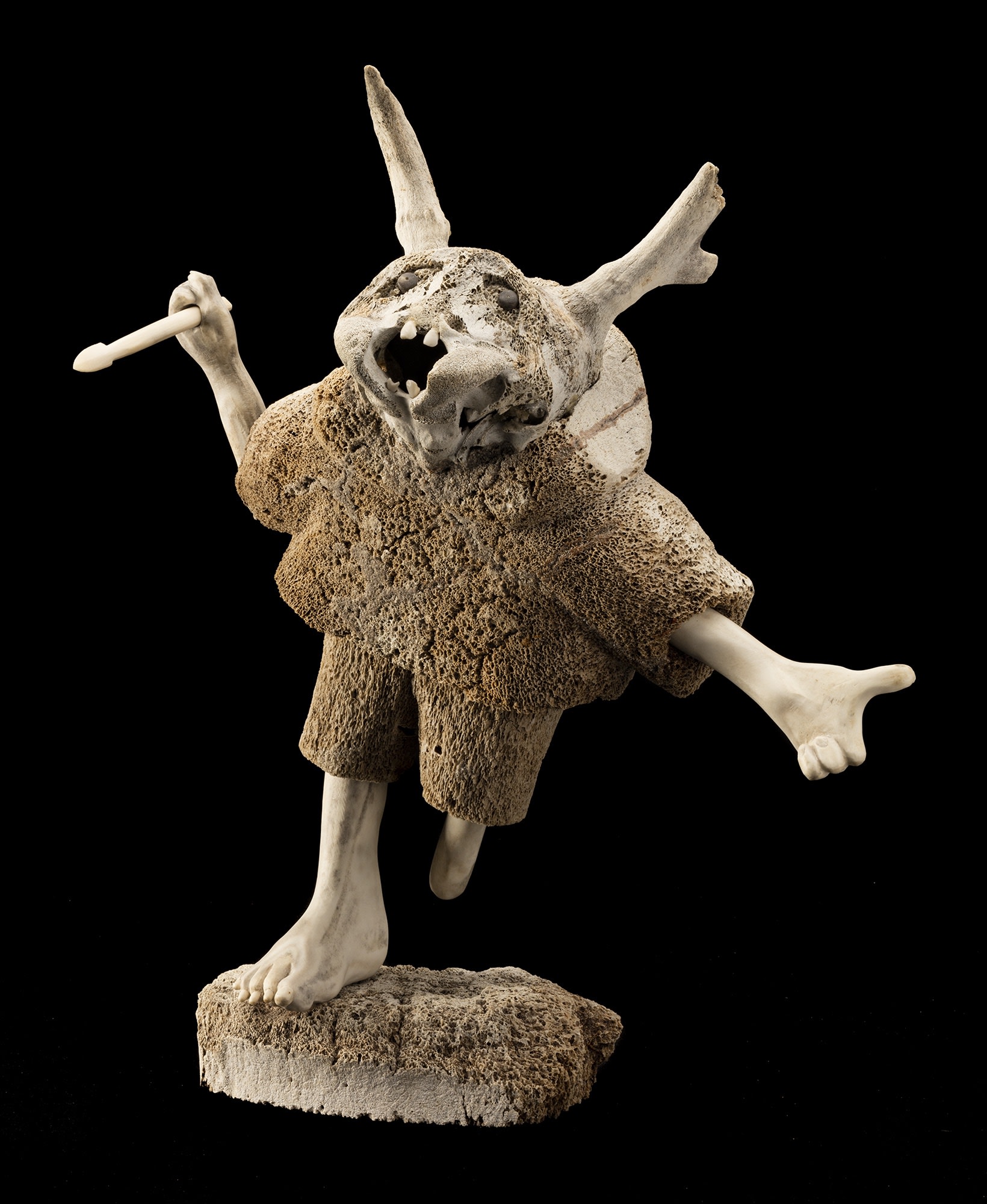Lot 36
NICK SIKKUARK (1943-2013) KUGAARUK (PELLY BAY) / UQSUQTUUQ (GJOA HAVEN)
Shaman, c. 1987
whale bone, caribou skull, caribou antler, and teeth, 16 x 12 x 6 in (40.6 x 30.5 x 15.2 cm)
signed "ᓂᑯᓚ ᓯᑯᐊ".
Estimate: $7,000 — $10,000
Price realized: $24,000
Provenance
Innuit Gallery of Eskimo Art, Toronto;
Acquired from the above by a Private Collection, Montreal.
Exhibited and Published
Innuit Gallery of Eskimo Art, Nick Sikkuark of Gjoa Haven (Toronto: Sept.-Oct. 1988), front cover (solo exhibition catalogue).
After abandoning his training to become a priest and working occasionally as a carpenter Sikkuark began carving in 1967, becoming well known for his ivory miniatures, and later for his quirky antler works in the early 1980s. He began working regularly on a larger scale, and with materials such as whale bone, in the mid-1980s when he was living in Gjoa Haven. Although influenced by that community's artists to some extent, he quickly found his own signature style:
I don't like to copy anybody. I like to be different from anybody else… I do a lot of carvings from my imagination, sometimes stories, sometimes what I have heard about the shamans… I like to do it my own way… I think, 'Nobody has ever seen this before… it's my imagination… we will never see it again in the future'… When I make a carving or drawing, I want people to think, 'What is that, what does that mean?' [1]
Sikkuark exploded onto the southern Inuit art scene with a breakout solo show at the Innuit Gallery in Toronto in 1988, which featured this extraordinary sculpture on the cover of the brochure. Although his style is more "realistic" than Karoo Ashevak's and his subject matter more ghoulish, in some ways Sikkuark is the true successor of Karoo's artistic legacy. Thematically Sikkuark's sculpture focuses largely on shamanism and the spirit world; in terms of technique, Sikkuark's imaginative choice of organic materials and his meticulous and brilliant utilization, juxtaposition, and transformation of these materials is seldom matched.
In her exhibition catalogue Art & Expression of the Netsilik Darlene Wight mentions a transformative experience from Nick Sikkuark's childhood, one he mentioned to her in a 1996 interview: "…he once told about a childhood experience of coming across a surface grave on the tundra, with the skull protruding from under the covering skin. Sikkuark's artistic imagination has been influenced by this memory" (p. 36).
We can imagine how an experience like that might be both haunting and inspirational. Shaman certainly exemplifies both Sikkuark's mature artistic imagination, which ranges from the mildly morbid to the downright demonic, and his consummate carving skill. While there is a distinct possibility that this remarkable sculpture represents a bad shaman, it might instead depict either a shaman temporarily possessed by an evil spirit, or perhaps one who is simply determined to give his séance audience a good fright.
1. Excerpt from a 2004 artist interview by Ingo Hessel, published in Ingo Hessel, Arctic Spirit (D&M/Heard Museum, 2006) p. 119.
References: For a similar figure of a shaman by Sikkuark from c. 1990 see Darlene Coward Wight, Art & Expression of the Netsilik (Winnipeg Art Gallery, 2000) cat. 22. For other important contemporaneous sculptures by Sikkuark in the Sarick Collection at the AGO, see Ingo Hessel, Inuit Art: An Introduction (Douglas & McIntyre, 1998), figs. 95-96. For a discussion of Sikkuark's sculptural style see Robert Kardosh's two-part article, "Natural Fantasia: The Wonderful World of Nick Sikkuark (Part I) in IAQ (Spring 2005), pp. 8-14; (Part II) in IAQ (Summer 2005), pp. 10-16.

